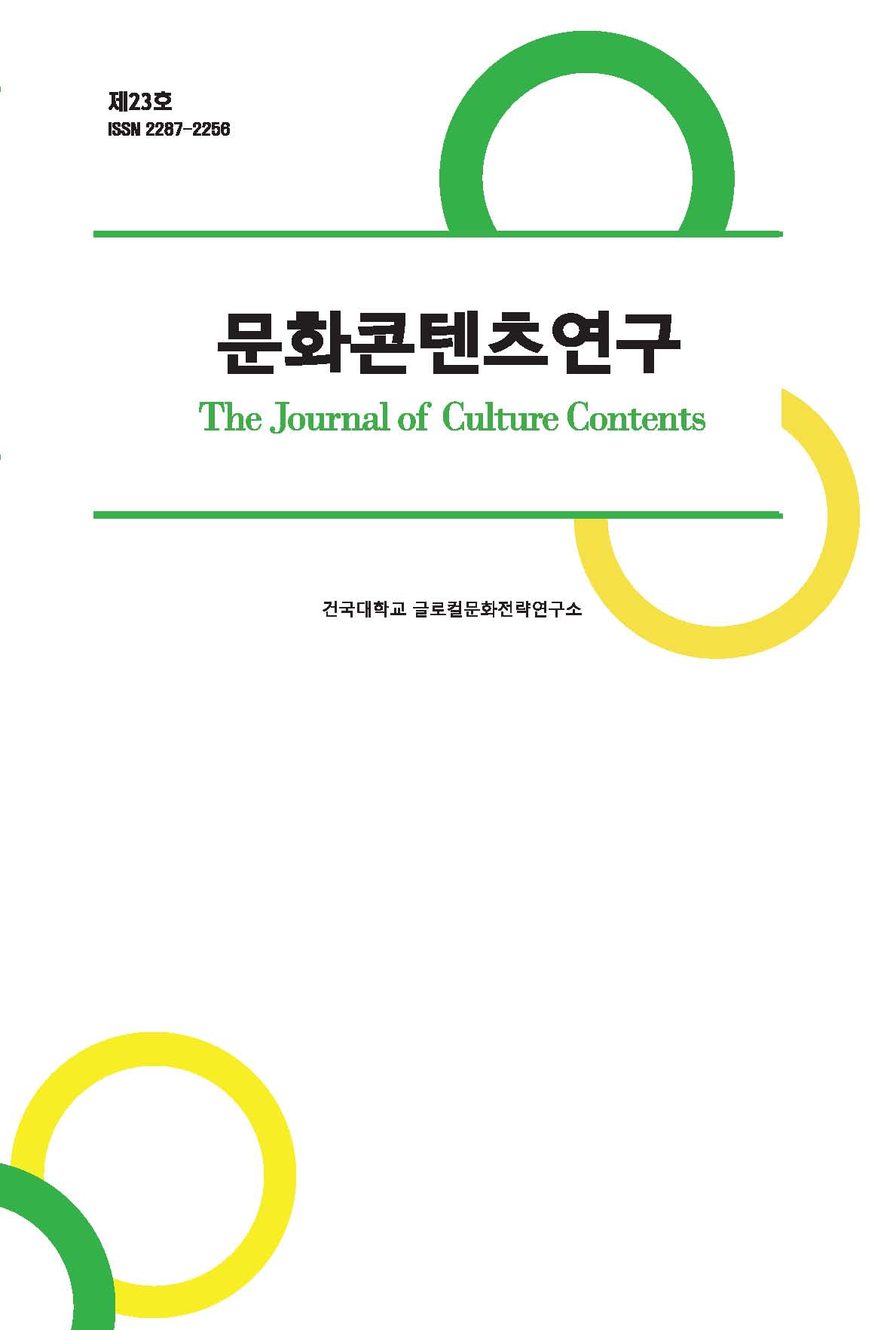Research Article
Abstract
References
Information
In this study, the prototypical structure of ‘real vs. fake confrontation’ meme and its various transmission aspects are analyzed. ‘Real vs. fake confrontation’ meme is one of the most socially and culturally successful meme.
In chapter 2, the prototypical structure of ‘real vs. fake confrontation’ meme is analyzed through the folktale . Folktales have been stored in the brain for many years in a form that enables long-term memory as they have been passed from mouth to mouth. Folktales, which are still carried through various media, are in themselves ‘successful’ memes. Therefore, folktales are the best data for revealing the true nature of cultural genes stored in people’s brains. The important feature that appears in the ‘real vs. fake confrontation’ meme is ‘people’s hidden desire on real’. And the fact that the real kicked out by the fake regains its position is a key feature in the prototypical structure of ‘real vs. fake confrontation’ meme.
In chapter 3, various transmission aspects of ‘real vs. fake confrontation’ meme are analyzed focusing on visual media. Visual media is the ‘replication tool’ of a meme that is most effectively used in modern society. Text delivered through visual media such as TV can clearly show how cultural genes from folktales are preserved and passed down in modern culture. This ‘real vs. fake confrontation’ meme is found in lots of various media text such as the movie (2012), and the TV show . As a result, the ‘real vs. fake confrontation’ meme is able to confirm that the fake is gradually transformed into a structure where the real and the fake coexist together, and the fake is gradually regenerated as a new real.
본 연구에서는 오늘날 전승되고 있는 수많은 밈(meme, 문화적 유전자) 가운데 가장 성공적이라 할 수 있는 ‘진짜-가짜 대결’ 밈에 주목하여, 그 원형적 구조를 밝히고 다양한 전승 양상을 분석하고자 하였다.
먼저 2장에서는 민담 <쥐 좆도 모른다>를 분석하여 ‘진짜-가짜 대결’ 밈의 원형적 구조를 분석하였다. 효과적인 밈일수록 충실도가 뛰어난 ‘장기기억’을 만들어 내는데, 현재까지도 다양한 매체를 통해 전승되고 있는 민담은 그 자체로 ‘성공적인’ 밈이라고 할 수 있다. 따라서 민담은 사람들의 뇌 속에 저장되어 있는 밈의 실체를 밝히기 위한 최적의 자료가 된다. 분석 결과, ‘진짜-가짜 대결’ 밈에서 나타나는 중요한 특징은 ‘자신들이 원하는 모습을 보여준 가짜를 진짜로 믿는 주변 사람들의 숨겨진 소망 내지 욕망’이었다. 또한 가짜에 의해 쫓겨난 진짜가 자신의 자리를 되찾는 것이 ‘진짜-가짜 대결’ 밈의 원형적 구조에 나타나는 핵심적 특징이었다.
다음으로 3장에서는 영상매체를 통해 전승되는 ‘진짜-가짜 대결’ 밈의 양상과 특징을 분석하였다. ‘영상 매체’는 현대사회에서 가장 효과적으로 사용되고 있는 밈의 ‘복제 도구’이다. 오늘날 가장 효과적인 밈의 전달 수단인 영상 매체를 통해 보존되고 있는 밈은 높은 생존가를 지니고 있는 것으로, 그만큼 수많은 사람들에게 영향을 미칠 수 있는 ‘강력한 심리적 매력’을 가졌다고 할 수 있다. 본 연구에서는 영상 매체
를 통해 전파되는 다양한 텍스트 가운데서도 한국 영화 <광해, 왕이 된 남자>와 TV프로그램 <히든싱어>에 주목하여 ‘진짜-가짜 대결’ 밈의 전승 양상을 살펴보았다.
민담 <쥐 좆도 모른다>에서 확인된 ‘진짜-가짜 대결’ 밈은 진짜가 자신의 자리로 돌아가는 것을 큰 축으로 하였으나, 영화 <광해>에서 발견되는 ‘진짜-가짜 대결’ 밈은 진짜 보다도 더욱 성장한 가짜가 ‘새로운 진짜’가 되는 가능성을 보여주었다. <히든싱어>에는 ‘진짜-가짜 대결’ 밈의 다양한 양상이 혼합되어 나타난다. 그것은 진짜 가수가 우승하기를 바라는 소망과 가짜 가수가 새로운 우승자로 태어나기를 바라는 소망이 혼합되어 있기 때문이다. 그래서 진짜가 자신의 자리를 굳건히 지키는 방향으로 나아가기도 하고, 가짜가 새로운 진짜로 거듭나는 방향으로 나아가기도 한다.
‘진짜-가짜 대결’ 밈은 진짜가 자신의 자리를 되찾아 가는 원형적 구조에서 점차 나아가 가짜가 새로운 진짜로 거듭나며, 진짜와 가짜가 함께 상생하는 구조로까지 변이되어 전승되고 있음을 확인할 수 있었다.
- 대니얼 데닛, 유자화 옮김, 『의식의 수수께끼를 풀다』, 옥당, 2013.
- 리처드 도킨스, 홍영남 옮김, 『이기적 유전자』, 을유문화사, 1993.
- 수전 블랙모어, 김명남 옮김, 『밈-문화를 창조하는 새로운 복제자 meme 』, 바다출판사, 1999.
- 강미정, 「<쥐 좆도 모른다>의 서사적 특성과 그 문학치료적 효용」, 『고전문학과 교육 』 제13집, 한국고전문학교육학회, 2007.
- 유진희, 「한국의 감성적 문화유전자 ‘정(情)’의 글로벌 수용가능성에 대한 탐구」, 『콘텐츠 문화 』 6호, 문화예술콘텐츠학회, 2015.
- 황혜진, 「한국 드라마로 이어지는 고전서사의 전통-드라마 <적도의 남자>(2012)를 중심으로」, 『겨레어문학 』 제49집, 겨레어문학회, 2012.
- Oring, E. Memetics and Folkloristics: The Theory. Western Folklore 73(4), 2014.
- Oring, E. Memetics and Folkloristics: The Applications. Western Folklore 73(4), 2014.
- Pimple, K. D. The Meme-ing of Folklore. Journal of Folklore Research, 1996.
- Zipes, J. What makes a repulsive frog so appealing: Memetics and fairy tales. Journal of Folklore Research, 2008.10.2979/JFR.2008.45.2.109
- Zipes, J. The meaning of fairy tale within the evolution of culture. Marvels & Tales 25(2), 2011. 10.23943/princeton/9780691153384.003.0002
- Publisher :Research Institute of Creative Contents
- Publisher(Ko) :글로컬문화전략연구소
- Journal Title :The Journal of Culture Contents
- Journal Title(Ko) :문화콘텐츠연구
- Volume : 16
- No :0
- Pages :91-111


 The Journal of Culture Contents
The Journal of Culture Contents





